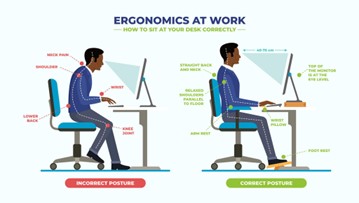
As workers, we often spend most of our time working in front of computers or other machines. However, this is often done without paying attention to our body’s health. Many of us don’t realize that working with the wrong posture can cause ergonomic risks. This risk can affect the health and performance of workers, as well as impact the company’s overall productivity.
What are ergonomic risks?
Ergonomic risks are health risks associated with working in an incorrect body position or with repetitive movements. This often happens when workers do not pay attention to their body posture or are not provided with an appropriate work environment. Some examples of ergonomic risks are back pain, neck pain, and nerve disorders.
Ergonomic risk factors
There are several factors that can increase ergonomic risks in the workplace. Some of them are:
- Poor posture. Working with poor posture can cause stress on the spine and muscles. This can cause back pain and spinal disorders.
- Inappropriate height of tables and chairs. If tables and chairs are not adjusted to the worker’s height, the worker will feel uncomfortable and force their body to adjust. This can cause muscle and nerve disorders.
- Repetitive movements. Repetitive movements, such as lifting heavy objects or using a mouse continuously, can cause muscle fatigue and nerve problems.
The impact of ergonomic risks on worker health
Ergonomic risks can have a negative impact on worker health. Some of the impacts that often occur are:
Back and neck pain. Poor posture and stress on the spine can cause back and neck pain.
Nervous disorders. Repetitive movements can irritate the nerves and cause tingling or numbness in the hands and arms.
Muscle disorders. Pressure on the muscles and repetitive movements can cause muscle disorders, such as carpal tunnel syndrome.
Ergonomic Risk Prevention Steps
Ergonomic risks can have a detrimental impact on worker health and productivity. Therefore, it is important for Prodia Colleagues to pay attention to ergonomics in the workplace. Some steps that can be taken are:
- Provide a suitable work environment. Companies must provide tables and chairs that suit workers’ height. Apart from that, you must also ensure that the position of the monitor and keyboard is appropriate to the worker’s body posture.
- Teaches correct work techniques. Companies can provide training to workers regarding correct work techniques, such as how to lift heavy objects and use a mouse correctly. This can reduce the risk of repetitive movements.
- Encourage regular rest. Workers need to take regular breaks to avoid muscle fatigue and increase productivity. Companies can encourage workers to take adequate breaks and stretch.
To maintain worker health and productivity, ergonomic risks must be considered in the workplace. By providing a suitable work environment, teaching proper work techniques, and encouraging regular breaks, companies can minimize ergonomic risks and improve worker health and productivity.





